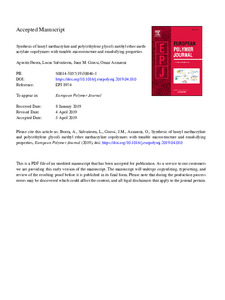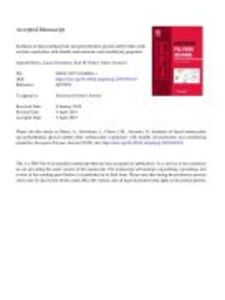Por favor, use este identificador para citar o enlazar este ítem:
https://repositorio.uca.edu.ar/handle/123456789/9020| Título: | Synthesis of lauryl methacrylate and poly(ethylene glycol) methyl ether methacrylate copolymers with tunable microstructure and emulsifying properties | Autor: | Iborra, Agustín Salvatierra, Lucas Matías Giussi, Juan M. Azzaroni, Omar |
Palabras clave: | POLIMEROS; PROPIEDADES TERMODINAMICAS; COMPOSICION QUIMICA; QUIMICA; MICROESTRUCTURA | Fecha de publicación: | 2019 | Editorial: | Elsevier | Cita: | Iborra, A. et al. Synthesis of lauryl methacrylate and poly(ethylene glycol) methyl ether methacrylate copolymers with tunable microstructure and emulsifying properties. [en línea]. Postprint del artículo publicado en European Polymer Journal. 2019. doi 10.1016/j.eurpolymj.2019.04.010. Disponible en: https://repositorio.uca.edu.ar/handle/123456789/9020 | Resumen: | Abstract: In this work we study the synthesis and properties of copolymers constituted of lauryl methacrylate and poly(ethylene glycol) methyl ether methacrylate monomers, prepared by atom transfer radical copolymerization in the entire composition range (with low and high monomer conversion). We propose a description of the copolymer microstructure, and evaluate the composition drift effect in the thermal and solution properties of the obtained copolymers. Nuclear magnetic resonance (NMR) was used to determine the chemical composition of the copolymers, while differential scanning calorimetry and themogravimetric analysis was employed to understand the thermal chracteristics. Rheological studies were conducted to obtain the viscosity and viscoelastic properties that were correlated with thermal transitions at different temperatures. Finally, dynamic light scattering (DLS) and surface tension measurements were used to evaluate the copolymer solution properties. The incorporation of an oil phase in the self-assembled aggregates was evaluated by DLS and characterized by atomic force microscopy, diffusion-ordered spectroscopy NMR and nuclear Overhauser effect NMR spectroscopy.. Our results suggest a longer sequence of LMA units in the copolymer chain and a drift effect in the case of high monomer conversions. A clear dependence on copolymer composition and microstructure to disperse an oil phase in water was observed. We believe that these results bring valuable knowledge that advances the field of macrosurfactants as well as their potential applications in oil recovery and other industrial processes. | URI: | https://repositorio.uca.edu.ar/handle/123456789/9020 | ISSN: | 0014-3057 | Disciplina: | QUIMICA | DOI: | 10.1016/j.eurpolymj.2019.04.010 | Derechos: | Acceso abierto. 2 años de embargo | Fuente: | Postprint del artículo publicado en European Polymer Journal, 2019 |
| Aparece en las colecciones: | Artículos |
Ficheros en este ítem:
| Fichero | Descripción | Tamaño | Formato | |
|---|---|---|---|---|
| synthesis-lauryl-methacrylate-poly.pdf | 1,74 MB | Adobe PDF |  Visualizar/Abrir | |
| synthesis-lauryl-methacrylate-poly.jpg | 3,53 kB | JPEG |  Visualizar/Abrir |
Visualizaciones de página(s)
214
comprobado en 30-abr-2024
Descarga(s)
405
comprobado en 30-abr-2024
Google ScholarTM
Ver en Google Scholar
Altmetric
Altmetric
Este ítem está sujeto a una Licencia Creative Commons

